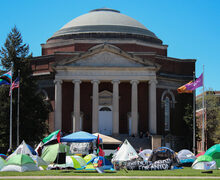Mayor Ben Walsh reaffirms support for Interstate 81 community grid option
Josh Shub-Seltzer | Staff Photographer
Walsh has voiced his support for the community grid I-81 replacement option despite a decision from Cuomo to include a tunnel option in a major project report.
Ben Walsh, in his first two weeks as mayor of Syracuse, had to strongly reaffirm his support of a replacement option for a deteriorating section of Interstate 81 that cuts through the city.
New York state Gov. Andrew Cuomo, while laying out his 2018 legislative agenda during a speech in Albany, said transportation officials would include a tunnel option to replace I-81 in a major project report.
That report, called a draft environmental impact statement, will provide a recommendation to the New York State Department of Transportation on what multibillion-dollar option they should select for the project. Shortly after Cuomo’s speech, an NYSDOT spokesman confirmed that the report’s release would be delayed until 2019.
Originally, the report was expected to be published sometime in 2018. Walsh, soon after Cuomo’s speech, weighed in on the project:
“I will be a consistent and passionate voice for the community grid option,” Walsh said in his public inauguration address on Jan. 6. “As evidence by the applause, the overwhelming majority of city residents see what I see.”
The debate over I-81 has dragged on for years. The highway was expected to reach the end of its useful life in 2017, according to the NYSDOT. Since 2009, the state agency has been studying how to best replace Syracuse’s “viaduct,” which is visibly rusting and crumbling in some spots.
NYSDOT officials have focused on three replacement options. The first is the community grid. The grid would redirect interstate traffic around Syracuse on Interstate 481 and replace the viaduct with a street-level roadway, similar to Erie Boulevard. That option would cost an estimated $1.3 billion and has garnered the support of several of the city’s common councilors.
The second option is a “rebuild” plan. To comply with federal regulations, the raised highway would simply be torn down and rebuilt wider and higher. That would cost an estimated $1.6 billion.

Wasim Ahmad | Staff Photographer
In an interview with Syracuse.com, Walsh also said he spoke with Cuomo and the governor’s staff after the State of the State address on Jan. 3, expressing his support for the grid.
“We would like to see it happen sooner,” Walsh told Syracuse.com. “But the process is what it is.”
Tunneling options were initially dismissed by the NYSDOT. But following political pressure, specifically from Sen. John DeFrancisco (R-DeWitt), Cuomo ordered officials to commission an independent study of a possible I-81 tunnel underneath Syracuse.
That study, delayed until December 2017, found that an “Orange” tunnel alternative would be financially feasible. The Orange route would cost up to $4.5 billion and cut underneath a public housing community, Pioneer Homes, and Syracuse University’s steam station and chilled water plant.
Walsh throughout his mayoral campaign called on the NYSDOT to release its draft environmental impact statement. He also held a rally in late September on Almond Street, adjacent the viaduct, to promote a grid concept. In early October, Walsh attended a rally in support of the grid in Hanover Square near City Hall.
During that rally, speaking before a crowd of about 100 people, Walsh said he was confused as to why Syracuse was stuck in the past and cities such as Pittsburgh were preparing infrastructure for self-driving cars.
“We are continuing to debate whether or not we want to double down on 20th century infrastructure when we’re in a 21st century economy,” Walsh said. “It makes no sense to me … we have been waiting for far too long for that (draft environmental impact statement). We know it exists. It’s time that the state releases that DEIS.”
Both Walsh and Juanita Perez Williams, the Democratic candidate for mayor who lost the election by roughly 4,000 votes, also said during the campaign a community grid would give local artists a positive opportunity to paint murals in a section of downtown.
Published on January 15, 2018 at 6:48 pm
Contact Sam: [email protected] | @SamOgozalek




